The Dutch, whose presence in North America was not of long duration (about 40 years), were interested primarily in trade and viewed Indians as something to be tolerated, like cold winters and hot summers. In general the Dutch appeared to have little interest in learning about the Indians and their culture. Like other Europeans, the Dutch never questioned the idea that Dutch culture was richer, stronger, more highly developed, and closer to God than the Indian cultures. From an Indian viewpoint, the Dutch were seen as not being hospitable for they gave few presents and charged for repairing guns.
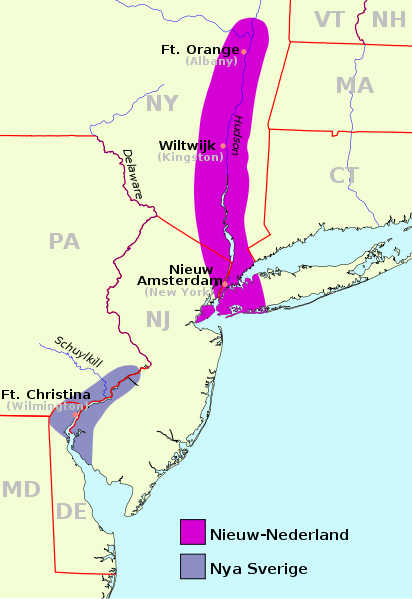
Regarding the Indians, the Dutch generally followed a policy of live and let live: they did not force assimilation or religious conversion on the Indians. Both in Europe and in North America, the Dutch had little interest in forcing conformity on religious, political, and racial minorities. They were not particularly interested in forcing Christianity upon the Indians.
The Dutch came to North America to make money and were not interested in imperial strategies. The Dutch were in the beaver business; therefore they were concerned with sustaining the Indian nations who were providing them with beaver pelts. They viewed the Indians as trading partners and therefore a source of wealth.
Between 1614 and 1624, it is generally estimated that the Dutch fur traders obtained about 10,000 beaver skins annually from the Connecticut Indians alone. To facilitate this trade, the Dutch traders began using wampum as a type of currency. They acquired wampum from the Pequots and Narragansetts in exchange for European trade goods. The Dutch then carried this wampum to Indians in the interior, exchanging it for furs.
In 1648, the Dutch estimated that 80,000 beaver pelts per year were passing through Manhattan on their way to European markets. In addition, they noted the growing importance of tobacco: Amsterdam was now the tobacco capital of Europe. The Dutch created a variety of tobacco blends to suite a range of prices and tastes. Tobacco grown in the English colony of Virginia was often shipped to Europe through the Dutch colony at Manhattan.
The Dutch fur traders, like those of the other European nations, were not renowned for their elegance and refinery. From a European perspective, their manners and honesty were often lacking. It was not uncommon for them to attempt to cheat the Indians. In spite of conflicts over this, dishonest trading practices did not lead to war as the trade was too profitable to both sides.
Among the items which the Indians, particularly the Iroquois, demanded in exchange for their furs were guns and the ammunition for them. The Dutch supplied their Indian trading partners with guns and with these guns, the Indians expanded their territory, often displacing tribes which did not have access to guns.
Another important trade item was alcohol. Officially, the Dutch enacted a number of laws designed to stop the liquor traffic with Indians, but these tended to be ignored. Since the Indians were willing to pay high prices for Dutch beer and brandy, there were many Dutch colonists who were willing to supply the demand without much regard for the consequences.
While the Dutch made some effort to be fair to the Indians when applying Dutch law to them, the Indians also learned that they could utilize the Dutch laws. One example of this was seen in 1647 when Harmen van der Bogaert, a Dutch barber-surgeon who was married with four children, was discovered having sex with another man. He fled deep into Mohawk country, seeking refuge in a village where he had been befriended years earlier. The Dutch authorities, however, tracked him down. There was a shootout in a longhouse and, as a distraction, van der Bogaert attempted to burn the building down. He was captured and taken to Fort Orange. The Mohawk, knowing something of European law, sent a delegation to Manhattan to sue the West India Company for damages to their building and supplies. After hearing their case, Peter Stuyvesant concluded that the Indians are right. He ordered the sale of van der Bogaert’s property with the money from the sale going to pay for the company’s debt to the Mohawk.
With regard to religious conversion, only two ministers of the Dutch Reformed Church made any serious effort to convert Indians. They failed to make any converts.
Both the Dutch and the Swedes bought Indian land to legalize their occupancy in the eyes of other Europeans. They recognized the Indians’ ownership of the land and thus the legal necessity of buying land before appropriating it. In general, the Dutch tended to be fair when buying land and cases of fraud and high-pressure tactics were the exception rather than the rule. The Dutch bought the land around New Amsterdam before they needed it and the Indians continued to occupy it undisturbed for years after the purchase.
Part of the conflict with the Indians over land purchases stemmed from different views of the transactions. Indians viewed the land as community property which belonged to the entire tribe or band for their use in perpetuity. They did not view it as a commodity to be bought and sold. The Indians thus viewed land purchases as simply payments for temporary use, while the Dutch looked upon these as final sales. Conflict arose when the Indians demanded from the Dutch further payments or for them to vacate the land.
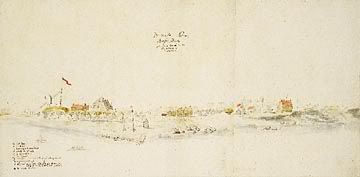
A drawing of New Amsterdam is shown above.
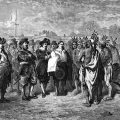
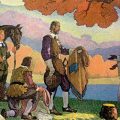

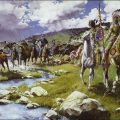
wow if i was a indian i would want the dutch to be my neighbour rather than those spanish which my actual indian ancestors lived next to